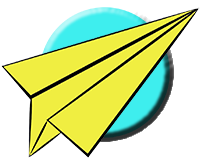How to Make the Typhoon Paper Airplane
How to Make the Typhoon Paper Airplane
Instructions
1. Bring the upper left corner of the paper down to the bottom edge of the sheet to make a crease. The right end of thise crease should hit the upper right corner of the paper exactly.
2. Unfold the crease just made.
3. Reposition the paper and make a similar crease, this time with the upper right corner of the paper. Bring the corner down to the bottom edge of the paper and make sure the elft end of the new crease hits the upper left corner exactly.
4. Unfold the crease you have just made.
5. Reposition the sheet again and fold it exactly in half bringing the two narrow edges together. Make a sharp crease and then unfold.
6. Reposition the sheet and prepare to reverse the upper section of the two diagonal creases you have made previously.
7. Bring both upper corners toward the center line. The crease from the upper corners to the center line must become mountain folds. It may be easier to make this fold if you reveres this section of both creases before proceeding.
8. Push the peak formed by the last step down flat. Make sure the center line lines up exactly. You will create two new creases while doing this. Push them down flat and make sure they are tight and even.
9. Turn your work over so that the flat edge is toward the top with the pointed end downward. Bring the top edge downward making a creases allt he way across the sheet. The ends of this crease should hit the intersection of the edge of the paper with the two diagonal folds which make up the point.
10. Turn your work over so that the flat edge is again toward the top with the two nails pointed downward.
11. Fold the top edge downward to make a flap. You will make a crease all the way across the sheet which parallel to the top edge and just touches the point. The point and all the layers near it end up under the new flap.
12. Bring the upper right corner down to make a new diagonal crease righ along the existing diagonal flap. The left end of this new crease should hit the center line exactly. If all is well, the right edge will come down exactly on the right diagonal edge of the paper.
13. Make an identical crease on the left side. Bring the upper left corner down to make a new diagonal crease right along the existing diagonal flap. The right end of this new crease should hit the center line exactly. The left edge should come down exactly on the left edge of the paper.
14. Bring the point downward to form a new crease across the work piece. The point should come down exactly on the center line.
15. Turn the plane over and move it so that the flat nose is toward the left and the two pointed tails are toward the right.
16. Fold exactly in half along the existing center line.
17. Rotate the plane around so that the flat nose side is toward the right and the pointed tail section is toward the left.
18. Fold the top flap down toward you creating a new crease through the thick narrow section on the lower right. This crease should continue the line of the bottom edge of this flap. Press play forward to continue and finish the fold.
19. Fold a small flap up from the wingtip to form a new crease about two finger widths from the tip. This crease should be parallel with the previous main wing crease.
20. Turn the plane over while keeping the wingtip flap you just made down toward you.
21. Bring the other wingtip down to form the second main wing crease identical to the first. Line all the edges up as well as possible to make sure the wings will be the same on both sides.
22. Repeat the wingtip fold by bringing the tip up to form a new flap. This crease should match the one you made on the other wingtip.
23. Open the wings and the wingtip flaps and adjust all creases so that the plane is about the same on both sides. The dihedral angle should be slightly up so that when it relaxes during flight, it is nearly flat.
THE THROW Launch with a gentle push at a slight up angle. A hard throw can cause looping. If it tends to circle back, adjust the wingtip flaps until they are vertical. When well trimmed this plane can float for a long straight flight from a high place.
